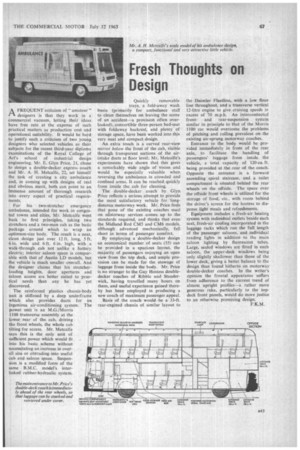Fresh Thoughts on Design
Page 69

If you've noticed an error in this article please click here to report it so we can fix it.
AFREQUENT criticism of "amateur " designers is that they work in a commercial vacuum, letting their ideas have free rein at the expense of such practical matters as production cost and operational suitability. It would be hard to justify such a criticism of two young designers who selected vehicles as their subjects for the recent third-year diploma examinations of the Royal College of Art's school of industrial design engineering. Mr. E. Glyn Price, 21, chose to design a double-decker express coach and Mr. A. H. Metcalfe, 22, set himself the task of creating a city ambulance and, in coming up with designs of real and obvious merit, both can point to an immense amount of thorough research into every aspect of practical requirements.
For his two-stretcher emergency ambulance, intended for work in congested towns and cities, Mr. Metcalfe went back to first principles, taking two stretchers and a two-man cab as the basic package around which to wrap an optimum-size body. The result is a neat, clean design just over 12 ft. long, 5 ft. 6 in. wide and 6 ft. 6 in. high, with a walk-through cab not unlike a battery electric; interior saloon space is comparable with that of Austin LD models, but the vehicle is much smaller overall And the designer claims that his stretcherloading heights, door apertures and saloon access are better suited to practical needs than any he has yet discovered.
The reinforced plastics chassis-body unit is stiffened by a deep underframe which also provides ducts for an ingenious air-conditioning system. The power unit is an M.G./Morris 1100 transverse assembly at the lower rear of the cab, driving the front wheels, the whole cab tilting for access. Mr. Metcalfe says this is the only unit of sufficient power which would fit into his basic scheme without necessitating an increase in overall size or obtruding into useful cab and saloon space. Suspension is a modified form of the same B.M.C. model's interlinked rubber-hydraulic system. Quickly removable trays, a fold-away wash basin (primarily for ambulance staff to clean themselves on leaving the scene of an accident—a provision often overlooked), convertible three-person bed-seat with foldaway backrest, and plenty of storage space, have been worked into this very neat and compact design.
An extra touch is a curved rear-view mirror below the front of the cab, visible through transparent sections of the airintake ducts at floor level; Mr. Metcalfe's experiments have shown that this gives a remarkably wide angle of vision and would be especially valuable when reversing the ambulance in crowded and confined areas. It can be reached quickly from inside the cab for cleaning.
The double-decker coach by Glyn Price reflects a serious attempt to provide the most satisfactory vehicle for longdistance motorway work. Mr. Price feels that none of the existing coaches used on motorway services comes up to the standards required, and thinks that even the Midland Red CM5 and CM6 models. although advanced mechanically, fall short in terms of passenger comfort.
By employing a double-decker design an economical number of seats (55) can be provided in a spacious layout. the majority of passengers enjoying an open view from the top deck, and ample provision can be made for the stowage of luggage from inside the body. Mr. Price is no stranger to the Gay Hostess doubledecker coaches of Ribble and Standerwick, having travelled many hours on them, and useful experience gained thereby has been employed in producing a new coach of maximum passenger appeal.
Basis of the coach would -be a 33-ft. rear-engined chassis of similar layout to the Daimler Fieetline, with a low floor line throughout, and a transverse vertical 12-litre engine to give cruising speeds in excess of 70 m.p.h. An interconnected frontand rear-suspension system similar in principle to that of the Morris 1100 car would overcome the problems of pitching and rolling prevalent on the existing air-sprung motorway coaches.
Entrance to the body would be provided immediately in front of the rear axle, to facilitate the handling of passengers' luggage from inside the vehicle, a total capacity of 120 Cu. ft. being provided at the rear of the coach. Opposite the entrance is a forward ascending spiral staircase, and a toilet compartment is situated behind the rear wheels on the offside. The space over the offside front wheels is utilized for the storage of food, etc., with room behind the driver's screen for the hostess to dispense light meals and refreshments.
Equipment includes a fresh-air heating system with individual outlets beside each seat, fresh-air cooling incorporated in the luggage racks which run the full length of the passenger saloons, and individual reading lights in addition to the main saloon lighting by fluorescent tubes. Large, sealed windows are fitted in each saloon, the upper-deck windows being only slightly shallower than those of the lower deck, giving a better balance to the design than found hitherto on motorway double-decker coaches. In the writer's opinion the frontal appearance suffers from adherence to the current trend of almost upright profiles—a rather more generous rake, particularly to the topdeck front panels, would do more justice to an otherwise promising design.
F.K.M.




















































































































